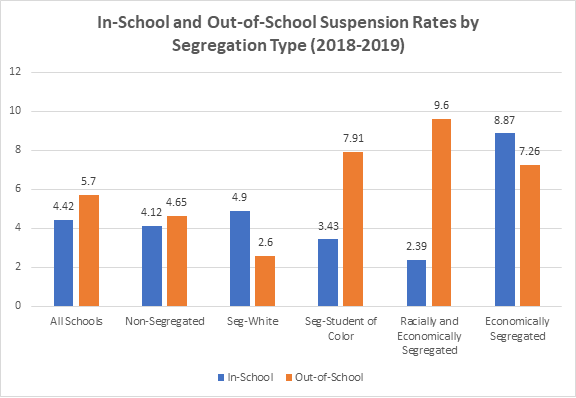By Elisabeth Kim, Ph.D. and Jamelia Harris, Ph.D.
Background and National Trends
There is substantial evidence that documents the profound and adversarial consequences of the overreliance on exclusionary discipline practices such as suspensions and expulsions on students’ school and life outcomes. For example, research shows how removing students from the classroom for disciplinary purposes negatively influences academic outcomes by limiting learning opportunities (Edley et al., 2019; Skiba et al., 2014) and contributing to decreased graduation rates (Rumberger & Losen, 2016) and increased risk of involvement with the juvenile justice system. Further, decades of research show that the implementation and enforcement of discipline falls disproportionately on certain groups across our nation’s school system. According to the U.S. Department of Education Office for Civil Rights, Black students represent 15.1 percent of enrolled students across the country, but account for 38.2 percent of students who have received an out-of-school suspension. Latinx students represent 27.2 percent of enrolled students in the U.S., but account for only 21.7 percent of out-of-school suspensions (CRDC, 2021). As data from our research reveals, the alarming patterns of discipline disproportionately faced by students of color in New Jersey schools mirror the trends documented in national studies. With financial support from the New Jersey State Policy Lab, the Joseph C. Cornwall Center for Metropolitan Studies is researching this issue with an eye on translating research into effective practice.
Although Black students are disproportionately represented in discipline outcomes, research shows there is no evidence that this population of students engages in more severe or higher rates of misbehavior that could warrant higher rates of punishment. Instead, racial/ethnic disparities in school discipline tend to be primarily found in more subjective infractions, such as defiance or disrespect, where interpretation rather than objective criteria are required (Gregory & Weinstein, 2008; Skiba, Michael, Nardo, & Peterson, 2002). Indeed, such patterns of inequity evidence the prevalence of systematic bias in the application of school discipline policies. This issue is further exacerbated at the intersections of race, class, and gender.
Examining School Discipline Trends in New Jersey
To explore the disparities in school discipline practices, we categorized NJ high schools based on student composition by race and economic disadvantage. Schools can be classified into five types; segregated – students of color (n=7 schools), segregated –students of color and economically disadvantaged (n=49), non-segregated (n=239), segregated – economically disadvantaged (n=37) and segregated – White (n=7). Schools that are ‘not racially segregated’ and ‘not economically segregated’ are considered ‘non-segregated schools.’ All other school types are considered ‘segregated schools’ based on racial and economic segregation. Among segregated schools, schools that are both economically segregated and racially segregated with high percentages of students of color are at the center of this analysis as these schools can best describe the disparities in school discipline between non-segregated and segregated schools. In 2018-2019, of the 49,344 students in economically segregated schools, 43.87 percent were Latinx, 24.78 percent were White, 23.53 percent were Black, 6.29 percent were Asian, and 1.13 percent were multi-racial. This analysis relies upon school-level rather than student-level data.
We analyzed the average suspension rates of schools for two years (2017-2018 and 2019-2020), segmenting the data by segregation type. The disparities in discipline practices between segregated and non-segregated schools have decreased, but overall suspension rates increased slightly from 2017-18 to 2018-19 (see Figures 1-2).
Compared to non-segregated schools and segregated schools with White students, three types of schools showed the highest rates of exclusionary discipline practices (i.e., out-of-school suspensions) (see Figure 2):
- Schools segregated with students of color
- Schools segregated with students of color and economic disadvantage; and
- Schools segregated with economic disadvantage
These schools also relied far more on out-of-school than in-school suspensions.
Figure 1: In-School and Out-of-School Suspension Rates for 2017-2018 in New Jersey
For example, in the 2018-2019 school year, 9.6% of students in racially and economically segregated schools received out-of-school suspensions, while only 2.39% of students in these schools received in-school suspensions (see Figure 3). The pattern can be found in the previous school year as well (see Figure 2). Interestingly, economically segregated schools had remarkably high suspension rates, sometimes higher than schools that were racially and economically segregated. This suggests that students’ economic background is associated with discipline practices at school.
Figure 2: In-School and Out-of-School Suspension Rates for 2018-2019 in New Jersey
Except for economically segregated schools, other types of schools showed low in-school suspension rates for both school years (see Figures 1 and 2). The three types of schools with the highest rates of out-of-school suspensions included those that were 1) racially and economically segregated, 2) segregated with students of color and 3) economically segregated. Racially segregated schools with White students had the lowest out-of-school suspension rates for both school years, implying that students of color are more likely to face out-of-school suspensions than their White counterparts in New Jersey.
References
Edley, C. F., Koenig, J. A., Nielsen, N., & Citro, C. F. (2019). Monitoring Educational Equity. National Academies Press Washington, DC. https://nap.nationalacademies.org/read/25389/chapter/1
Gregory, A., & Weinstein, R. S. (2008). The discipline gap and African Americans: Defiance or cooperation in the high school classroom. Journal of School Psychology, 38(3), 386–402. https://doi.org/10.1016/j.jsp.2007.09.001
Rumberger, R. W., & Losen, D. J. (2016). The high cost of harsh discipline and its disparate impact. https://www.civilrightsproject.ucla.edu/resources/projects/center-for-civil-rights-remedies/school-to-prison-folder/federal-reports/the-high-cost-of-harsh-discipline-and-its-disparate-impact
Skiba, R. J., Michael, R. S., Nardo, A. C., & Peterson, R. (2002). The color of discipline: Sources of racial and gender disproportionality in school punishment. Urban Review,34. https://doi.org/10.1023/A:1021320817372
Skiba, R. J., Chung, C.-G., Trachok, M., Baker, T. L., Sheya, A., & Hughes, R. L. (2014). Parsing disciplinary disproportionality: Contributions of infraction, student, and school characteristics to out-of-school suspension and expulsion. American Educational Research Journal, 51(4), 640-670. https://doi.org/10.3102/0002831214541670
U.S. Department of Education, Office for Civil Rights, Civil Rights Data Collection (CRDC). (2021). An Overview of Exclusionary Discipline Practices in Public Schools for the 2017-18 School Year. https://ocrdata.ed.gov/assets/downloads/crdc-exclusionary-school-discipline.pdf



